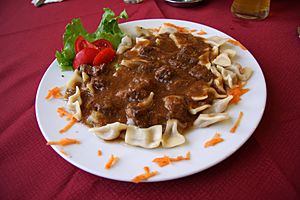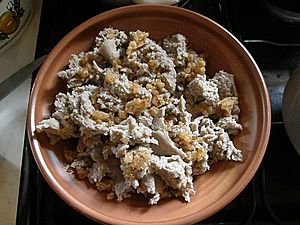Slovenian cuisine facts for kids

Slovenian cuisine (called slovenska kuhinja in Slovenian) is super diverse! It's shaped by Slovenia's different landscapes, weather, history, and even its neighbors. Imagine a country with mountains, plains, and a coastline – all these things affect what people eat. In 2016, experts divided Slovenia into 24 special food regions, each with its own unique dishes. The very first cookbook written in the Slovenian language was published way back in 1798 by a person named Valentin Vodnik.
Contents
What Kinds of Foods Do Slovenians Eat?
Soups might seem common now, but they're actually a newer part of Slovenian cooking. Before soups became popular, people often ate different kinds of porridges, stews, and one-pot meals. Many early soups didn't have meat and were quite simple.
One special dish is called aleluja. It's a soup made from turnip peels and was often eaten during times of fasting. A very common meat soup is beef soup with noodles. Families often enjoy this on Sundays as part of a big Sunday lunch, which might also include fried potatoes, fried steak, and lettuce. For holidays, people often choose between beef noodle soup or a creamy mushroom soup.
Popular Meats in Slovenia
Pork is a very popular meat all over Slovenia. Chicken and other poultry are also eaten a lot. Different parts of Slovenia have their own favorite meats. For example, in areas like White Carniola and the Slovenian Littoral, people eat mutton (sheep meat) and goat.
On St. Martin's Day, which is a special holiday, people enjoy roasted goose, duck, turkey, or chicken. These are often served with red cabbage and a type of pasta called mlinci. Long ago, in Lower Carniola and Inner Carniola, people even used to eat roasted dormouse and quail! Also, before a disease affected them in the 1880s, noble crayfish were a common food and a source of income in those same regions.
Fruits, Vegetables, and More!
Dandelion leaves are very popular in Slovenia for salads. People have been gathering them from fields for hundreds of years. Even today, a salad made with dandelion and potatoes is highly valued. Since dandelions can only be picked for a short time in early spring, people make the most of it. Families often go out together to pick enough dandelions for a whole week!
In the Middle Ages, people ate acorns and other fruits from the forest, especially when food was scarce. Chestnuts were also very important and used in many delicious dishes. Walnuts and hazelnuts are often used in cakes and desserts. Wild strawberries, loganberries, blackberries, and bilberries were great sources of vitamins.
Mushrooms have always been a favorite, and Slovenians love picking and eating them. There are many different kinds! Honey was also used a lot in cooking. Medenjaki are honey cakes that come in different shapes, often heart-shaped, and are frequently given as gifts.
Special Slovenian Foods with European Protection

As of June 2015, twenty-two Slovenian foods and food products have special protection from the European Union. This means they are recognized as unique to Slovenia and must be made in a certain way or place. Here are a few examples:
- Prleška tünka: This is a product from eastern Slovenia, made from minced lard (pork fat) and pork.
- Ptuj onion (ptujski lük): A special heart-shaped onion with a reddish color.
- Extra virgin olive oil from the Slovenian Istria (ekstra deviško oljčno olje Slovenske Istre): This olive oil is a bit bitter and spicy, with a strong fruity smell. It's made in the Slovenian Istria region.
- Nanos cheese (nanoški sir): A hard cheese made from cow milk. It has small, pea-sized holes and tastes a little sweet and spicy.
- Kočevje forest honey (kočevski gozdni med): Honey produced in the wider Kočevje area.
- Zgornjesavinjski želodec: An air-dried meat product from the Upper Savinja Valley. It's made from high-quality bacon and pork meat, stuffed into a pig stomach.
- Šebreljski želodec: Similar to the above, but made in the areas around Cerkno and Idrija.
- Idrijski žlikrofi (idrijski žlikrofi): These are small, boiled dumplings filled with potatoes, onions, and lard.
- Prekmurska gibanica: A famous pastry from Prekmurje. It has eight layers and is filled with poppy seeds, walnuts, apples, raisins, and ricotta cheese.
- Tolminc cheese (sir Tolminc): Made from raw cow milk in the Tolmin area. It tastes sweet and spicy.
- White Carniola loaf (belokranjska pogača): A traditional flatbread from White Carniola.
- Karst prosciutto (kraški pršut): A type of cured ham produced in the traditional way on the Karst Plateau in southwestern Slovenia.
- Karst cured neck meat (kraški zašink): A cylindrical meat product made from cured pork neck meat.
Well-Known Slovenian Dishes

- Ajdovi žganci
- Belokranjska povitica
- Bujta repa
- Funšterc
- Kmečka pojedina
- Kranjska klobasa
- Matevž
- Mavželj
- Mežerli
- Mineštra (minestrone)
- Obara (stew)
- Pirh
- Potica (nut roll)
- Prekmurska gibanica
- Ričet
- Špehovka
- Vipavska jota
Soups and Stews to Try
- Bakalca
- Bobiči
- Bograč
- Jota, Vipavska kisla juha (Vipava sour soup)
- Mineštra
- Prežganka is a Slovenian national soup made from flour, caraway seeds, and beaten eggs.
- Šara
- Štajerska kisla juha is a sour soup from Lower Styria. It's often made during a traditional pig slaughter feast, using pork feet and parts of the pig's head.
Vegetarian Dishes
- Ajdovi žganci: This is a dish similar to polenta, but made with finer grains. It was often served with sauerkraut in Upper Carniola.
- Aleluja
- Bezgovo cvrtje
- Čompe
- Fritaja (similar to frittata): A dish popular in Istria, especially in springtime. It often includes wild asparagus, wild hops, herbs, chicory, tomatoes, and young garlic sprouts mixed with eggs. Fritaje can also be made year-round with ham, mushrooms, sausages, or bacon.
- Idrijski žlikrofi
- Jabolčna čežana
- Kaša: A very old dish, commonly eaten in Eastern Europe.
- Krapi
- Maslovnik
- Matevž
- Medla
- Mešta
- Močnik: Made from grains like buckwheat, maize, wheat, millet, rye, or oats, cooked in either milk, cream, or soured cream.
- Njoki
- Smojka
- Štruklji
Meat Dishes
- Budelj
- Bujta repa
- Bunka (food)
- Furešna
- Jetrnice (liver sausage)
- Kranjska klobasa (Carniola sausage)
- Krvavice (black pudding)
- Mavta
- Mavželj
- Meso v tünki
- Mežerli
- Povijaka
- Prata
- Pršut (prosciutto)
- Šivanka
- Švacet
- Vampi (Tripe)
- Zaseka
- Želodec (stomach)
Desserts and Pastries
- Bobi
- Buhteljni
- Cmoki
- Hajdinjača
- Kremsnita
- Krhki flancati
- Krofi
- Kvasenica
- Miške
- Mlinci
- Ocvirkovica
- Pinca
- Pogača
- Posolanka
- Povitica or Potica (nut roll)
- Prekmurska gibanica
- Šarkelj
- Škofjeloški kruhek
- Špehovka (bacon roll)
- Vrtanek
- Zlevanka
Popular Slovenian Drinks
- Brinjevec
- Borovničke
- Jabolčnik (apple wine)
- Češnjevec (cherry brandy)
- Cviček (Slovenian wine from the Dolenjska region)
- Teran (Slovenian wine from the Primorska region)
- Kislo mleko (sour milk)
- Šabesa
- Slivovka, Slivovica
- Tolkovec
- Tropinovec
- Pinjenec (buttermilk)
- Union beer
- Laško/Zlatorog beer
See also
 In Spanish: Gastronomía de Eslovenia para niños
In Spanish: Gastronomía de Eslovenia para niños




